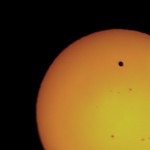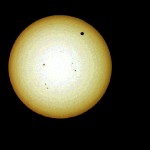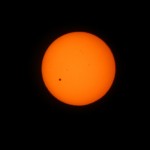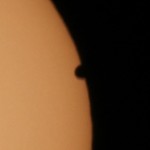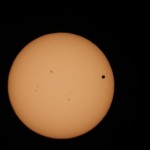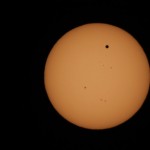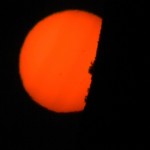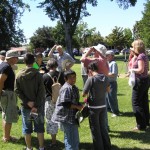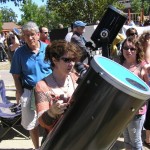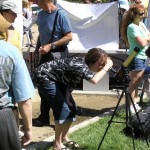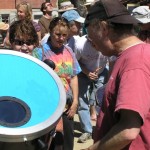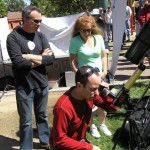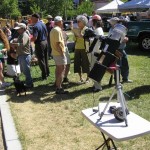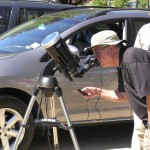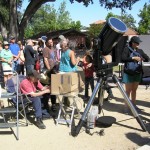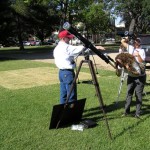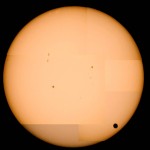
This event is over… thank you to everyone who participated. Together, CCAS reached over 1,000 people!
Here are some if the pictures from the transit:
A transit of Venus is the observed passage of the planet across the disk of the sun. The planet Venus, orbiting the sun “on the inside track” catches up to and passes the slower earth. Venus, appearing as a small dot in the foreground, will move from left to right across the sun. The word “transit” means passage or movement in this case, across the face of the sun.
Transits of Venus have a strange pattern of frequency. A transit will not have happened for about 121 ½ years (prior to 2004, the last one was 1882). Then there will be one transit (such as the one in 2004) followed by another transit of Venus eight years later (in the year 2012). Then there will be a span of about 105 ½ years before the next pair of transits occur, again separated by eight years. Then the pattern repeats (121 ½ , 8, 105 ½ , 8).
Where can I view the Transit? On June 5 at 3pm:
- The big CCAS Solar Transit Party at the City Park in Past at 3pm includes a bunch of scopes, including the ultra-popular h-alpha scope, Aurora’s own radio telescope, and several members are bringing their own so you can safely view the sun. Free solar viewers for the first 200 to look through the scopes.
- There’s a second viewing party with Jim Carlisle in Atascadero (call him at 466-5997 for directions)
- And another viewing party in Grover Beach with Joe Richards, who will be at the Pismo State Beach at the end of Grand Avenue in Grover Beach (by Fin’s Restaurant and the golf course). There are picnic tables right by the parking lot that we’ll be setup at. Additional scopes requested to help out.
What’s the Big Deal about the Transit?
Consider this brief history: In 1716 astronomer Edmond Halley calculated that you can quantify the distance from the sun to the earth by having observers across the globe time the passage of Venus across the sun. Knowing he would not live to see the next transit, Halley predicted global sites that would be suitable for viewing a transit and called upon future generations to pursue his plan. For the 1761 transit and every transit opportunity since then, explorers sailed to distant lands to time the transit. The quest to time the transit of Venus in 1761, during the Seven Years War, marked one of the first times the international community cooperated to answer one of the leading scientific questions of the day.
By quantifying the distance from the sun to the earth, a simple application of Kepler’s Third Law gives you the distances of all the planets from the sun, and thus the scale of the solar system. Knowing the size of the solar system gives more accurate parallax measurements of distant stars. Today, the transit of Venus as a means to measure the sun-earth distance is largely of historical interest, for tools such as radar have measured distances to planets much more accurately.
A transit is a great opportunity for the public concurrently to study the sun, which influences life on earth on both a planetary and a personal scale. A dynamic between the sun and earth sustains life here, while our personal lives–which are becoming more technology dependent–are impacted by the sun’s shenanigans.
You may view the sun and thus the planet Venus passing in front of the sun only if you use proper solar filters or indirect viewing techniques.
CCAS is handing out free viewers to all club members at their live event on June 5th 3-6pm. Click here for a flyer for this event!
 Transits of Venus across the disk of the Sun are among the rarest of planetary alignments. Since the invention of the telescope in 1609, only seven such events have occurred, and the next transit will occur on 6 June 2012. The transit is an important event because the distance to Venus can be used to calculate the distance from the Sun to all of the planets.
Transits of Venus across the disk of the Sun are among the rarest of planetary alignments. Since the invention of the telescope in 1609, only seven such events have occurred, and the next transit will occur on 6 June 2012. The transit is an important event because the distance to Venus can be used to calculate the distance from the Sun to all of the planets.
There first measurements were made by Jeremiah Horrocks and William Crabtree on 4 December 1639. With each successive transit, the distance was further refined, and, in 1882, measurements of the transit yielded a value of 92,702,000 miles. This distance is now used a unit of measure, and it is called an astronomical unit. Due to the fact that orbit of the Earth is an ellipse, the average distance to the Sun (now 92,755,700 miles) is used for the value of an astronomical unit. Once the distance to the sun was known, the distances to all the other planets could be easily derived.
Observations of the transits of Venus across the sun also yielded information on the size of the planet, its orbit, and provided the first evidence that it has an atmosphere. As better instruments and methods were developed, astronomers began to understand the members of our solar system in increasing detail. We came to understand our solar system’s history, and its likely future.
Once the distance to the sun was known, a race was on to determine distances to nearby stars. The astronomer’s tool once again was parallax, the apparent movement of nearby stars against the background of more distant stars as viewed from different places in the Earth’s orbit. Those measurements required an accurate value for the distance to the sun. With the aid of sophisticated telescopes, the tiny parallax angles to nearby stars could be measured. In the year 1839 the first stellar parallax was confirmed for three stars. The stars were 61 Cygni (Friedrich Bessel), Alpha Centauri (Thomas Henderson), and Vega (Wilhelm Struve).
Astronomers learned more and more information about our galaxy and the universe in general. As part of this journey of discovery, astronomers began to wonder if our solar system was unique among the billions of stars in each of billions of galaxies in the universe, and now able to study the universe using satellites. An impressive array of highly technical instruments scans the heavens gathering information about the wondrous place we call home.
Here are the local times of the transit phases:
June 5th:
- 1st Contact (Ingress Begins) 3:10 PM PDT Altitude 59
- 2nd Contact (Ingress Complete) Â 3:27 PM PDT Altitude 56
- Mid Transit 6:30 PM PDT Altitude 19
- Local Sunset approx 8:15
- 3rd Contact (Egress Begins) 9:32 PM PDT Â Altidude -13 below horizon
- 4th Contact (Egress Complete) 9:49 PM PDT Altitude -16 below horizon




